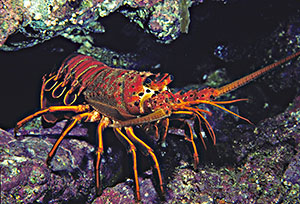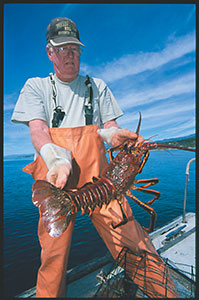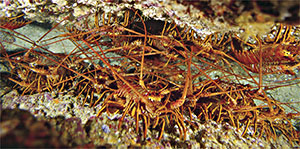California Spiny Lobsters in the Channel Islands
 Native Americans used them to fertilize their fields, and to bait their hooks in hopes of catching something more worth eating. During colonial times, they were considered "poverty food" and were harvested from tidal pools to be served to children, servants, and prisoners. Eventually the servants rebelled. They had it put into their contracts that no more than three times a week would they be forced – to eat lobster.
Native Americans used them to fertilize their fields, and to bait their hooks in hopes of catching something more worth eating. During colonial times, they were considered "poverty food" and were harvested from tidal pools to be served to children, servants, and prisoners. Eventually the servants rebelled. They had it put into their contracts that no more than three times a week would they be forced – to eat lobster.It’s true. According to one mythical tale, it was John D. Rockefeller, Sr. who rescued lobster from culinary embarrassment. In 1910, the Rockefellers established a summer home on Mt. Desert Island. The legend is that a bowl of lobster stew meant for the servants’ table was inadvertently sent upstairs—where it was rapturously received. Either unaware of the plebeian reputation of the dish, or not much caring what people thought, the master of the house gave it a permanent place on his menu—or so they say.
Nowadays, we Santa Barbarans bestow almost ritual status on the consumption of local lobster, from the cracking of the shells to the poking of our forks into the plump tail meat to the cleansing of our fingers with lemon water. From October through March (California spiny lobster season) we take our crustacean very seriously. It is our prized seafood, our filet mignon of fish. It's our celebration food, our holiday feast—the food we always serve when good cooks from out-of-town come to visit. And, although the Maine lobster is also fished commercially and is available throughout North America, any Santa Barbaran like me will tell you that the California spiny lobster is by far the better choice. It is coarser in texture, but sweeter, more flavorful, and packed with much more meat.
 Visitors to Santa Barbara tend to identify the California spiny lobster with the Santa Barbara Marina—the popular tourist destination where one can find legendary seafood restaurant Brophy Bros., and the Navy Pier – the dock where fishermen unload their catch day in and day out. (On weekends, fishermen fill plastic swimming pools with live lobster and sell their catch directly to the public). California spiny lobsters are nearly always sold either live or freshly cooked. In contrast, most Atlantic- and Australian-caught spiny lobsters are only available as frozen, raw tails.
Visitors to Santa Barbara tend to identify the California spiny lobster with the Santa Barbara Marina—the popular tourist destination where one can find legendary seafood restaurant Brophy Bros., and the Navy Pier – the dock where fishermen unload their catch day in and day out. (On weekends, fishermen fill plastic swimming pools with live lobster and sell their catch directly to the public). California spiny lobsters are nearly always sold either live or freshly cooked. In contrast, most Atlantic- and Australian-caught spiny lobsters are only available as frozen, raw tails.Considering my affection for local spiny lobster, I thought it would be fun to track them to their source. So one day last February I sauntered down to the Santa Barbara Marina at the crack of dawn to meet a pair of commercial lobster fishermen who had offered to take me out fishing for the day.
I stood at the edge of the dock with a cup of steaming coffee in my hands, listening to the harbor echo with the gentle rumble of big marine engines warming up. The sun crept over the liquid horizon as Bob Sharp (an ol’ salt if there ever was one) and his son Raleigh greeted me with the electrifying words “Let’s go fishing!' Spiny lobster is the general name given to about four dozen species of clawless lobster found in all tropical and subtropical waters of the world, as well as in the temperate seas of the Southern Hemisphere. Despite this variety, most are sold under the names warm water lobster (from Florida, California, or Hawaii) or cold water lobster (from Australia or New Zealand). The California spiny lobster ranges from northern California south to Baja Mexico. Here in Santa Barbara, the lobster fishery is well managed by the Department of Fish & Game, which keeps a close eye on these highly-prized critters. Current regulations appear to be effective at preserving the lobster fishery.
 As we motored up the coast towards Isla Vista, Raleigh slowed their thirty-three foot Peterson named Ramona so his father could grab the boat hook and lean over the side to snag the first trap line. Lobstering is usually done in the morning when the seas are calm; it's easier to spot the trap buoys as well as the floating fronds of kelp, which indicate the rocky bottom substrate preferred by lobsters.
As we motored up the coast towards Isla Vista, Raleigh slowed their thirty-three foot Peterson named Ramona so his father could grab the boat hook and lean over the side to snag the first trap line. Lobstering is usually done in the morning when the seas are calm; it's easier to spot the trap buoys as well as the floating fronds of kelp, which indicate the rocky bottom substrate preferred by lobsters.Commercial lobstermen like Bob and Raleigh set and fish between 100 and 300 traps, depending on the size of their boat and crew. Most of the old, wooden-lath traps have been replaced by newer ones made of wire on a metal frame. The metal traps are designed so that the lobster can easily enter and get to where the bait is. Once it’s there, it’s hard for it to get out – but not impossible: If a trap is left unattended for long periods of time, it’s usually empty when hauled up. Bob tells me lobster traps are set in rocky areas at depths of anywhere from 10 to 250 feet. Today, we’re working about a hundred yards offshore in rather shallow waters – around 50 feet. We have the gentle swells of the early morning sea to ourselves; the other fishermen have opted to try their luck farther out, around the Channel Islands.
From the moment Bob hooks the trap buoy, it’s clear the father and son team have this routine down to a science. Dad pulls in the trap buoy and grabs the line, which Raleigh takes and feeds around the wheel of the hydraulic winch mounted to the starboard side of the vessel. Powered by the boat’s engine, the winch does the heavy lifting. In such shallow water, the trap is soon on deck and Bob immediately jumps to the helm. We are already headed for the next trap marker as Raleigh opens the pot and measures each of the six lobsters inside. Some are undersize; for a lobster to be legally taken in California – commercially or for sport – it must measure at least 3 1/4 inches from the eye socket to the rear edge of the body shell.
Raleigh gently tosses each undersize lobster back to its watery lair while placing the legal lobsters into a plastic tub. Stuffing a couple of defrosted herring into the bait cup, Raleigh closes the trap and pushes it back over the side as Bob brings us alongside the next trap buoy. They will raise well over 100 traps today, a long, hard day’s work.
When alive, the California spiny lobster is a beautifully marked crustacean with mottled yellow, orange, green and blue over a predominately rust colored body. They may grow to twenty pounds, but most are between one and five pounds. Spiny lobsters lack the large claws of the Maine lobster, but more than make up for the absence of this weapon by having a shell covered with sharp spines; large, formidable looking antennae; and a large, powerful tail which can be used in defense or for rapid retreat.
For me, fresh California spiny lobster is best savored in its delightful simplicity. There are a number of great places serving it this way – outside my own home, that is. One is the Santa Barbara Shellfish Company located at the tip of Stearns Wharf. Saltwater tanks brimming over with live lobsters greet you as you wait in line for your chance to experience seafood bliss. General Manager Brendan Dwan tells me eight hundred to one thousand pounds of lobster are consumed here during the peak season – as lobster tacos, lobster cocktails, or simply boiled in the shell and cracked.
When picking out a live lobster, Brendan explains the freshest lobsters are those that are frisky; their tails curl up or flap rather than hang down limply when they are picked up. Other sources advise me to ask how long the lobster has been in the tank and to choose those that have been there less than a week. The lobster should also seem heavy for its size. And be sure the shell is hard, not spongy; a soft shell is the sign of a lobster that has recently shed, which means the meat will be a very low percentage of its total weight.
If buying cooked lobster, be sure the tail is pulled tightly up underneath the body, which indicates the lobster was alive when cooked. Fresh-cooked lobster should also smell fresh, with no hint of ammonia odor. The shell should be bright orange or red and any exposed meat should be white and moist, not dried out or yellow.
Besides the Shellfish Company, live California spiny lobsters are available during the season at the Fishermen’s market in the harbor, Coastal Catch (730-1941) and at the Saturday morning Farmers Market. Frozen lobster is available year-round.
For those preferring to experience California spiny lobster complete with white tablecloths and cellared wine, there are a number of fine restaurants in Santa Barbara that feature the celebrated crustacean. One of my favorites is Citronelle. In fact, Chef Isabelle Alexandre, who prides herself in perfecting many ways of preparing spiny lobster, conjured up a recipe just for me (she has graciously allowed me to include her creation at the end of this article).
As the day drew to a close, Bob and Raleigh Sharp brought me back to the harbor, where I took a moment to observe them selling their live catch to the Santa Barbara Shellfish Company. As I disembarked, I thanked the fishermen for a fine day at sea. Generously acknowledging the minimal help I’d tried to give this expert team, they gave me two hefty lobsters. Later that night, I cooked and prepared them like Isabelle had instructed me to. Seafood doesn’t get any better.